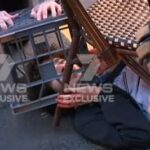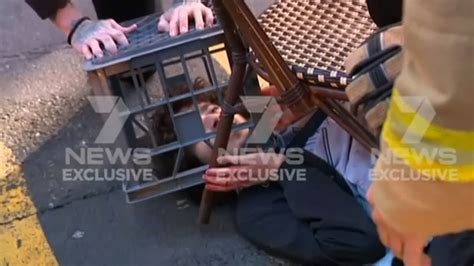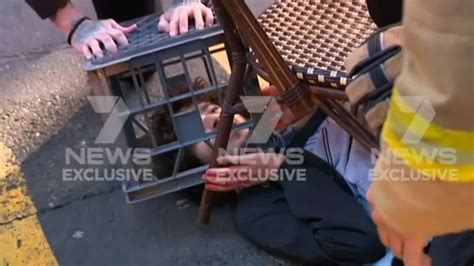
A tourist who fell into the crater of Mount Vesuvius, an active volcano in Italy, was allegedly abandoned by their guide, prompting an investigation by local authorities. The incident occurred over the weekend when the American tourist, identified as a 23-year-old man, trespassed on a restricted area to take a selfie and subsequently slipped into the volcano’s opening.
Italian authorities have launched an investigation into the circumstances surrounding the incident, focusing on allegations that the tourist was left unattended after the fall. The circumstances that led the tourist into the crater are part of the investigation, along with the conduct of the guide. The rescue operation involved specialized personnel and equipment to safely extract the injured man from the volcano’s steep inner slopes.
The American tourist, identified only by his first name, Philip, and age, 23, sustained minor injuries after falling several meters inside the crater of Mount Vesuvius. According to local reports, Philip was attempting to take a selfie when he lost his footing and plunged into the opening. He and his family reportedly took an unauthorized trail to reach the summit, bypassing marked routes intended for tourists accompanied by licensed guides.
“This tourist took another route, even though it was cordoned off,” Paolo Cappadocia, president of the Vesuvius National Park, stated.
The incident has raised serious concerns about safety protocols, unauthorized access to dangerous areas, and the responsibilities of tour guides in ensuring the well-being of visitors.
The Carabinieri, Italy’s national police force, along with the financial guard, intervened and pressed charges against the tourist and his family for trespassing on prohibited property. The investigation will also examine whether the guide adhered to safety regulations and properly supervised the group.
Details of the Incident
Mount Vesuvius, a volcano known for its historical eruption that buried Pompeii in 79 AD, is a popular tourist destination, attracting visitors from around the world. However, access to the crater’s edge is restricted, and visitors are expected to follow designated paths accompanied by licensed guides. These safety measures are in place to protect tourists from potential hazards, including the risk of falling, exposure to toxic gases, and the unpredictable nature of an active volcano.
Philip and his family, despite these restrictions, ventured onto a path that was clearly marked as off-limits. It is believed that they were attempting to get a closer view of the crater for photographic purposes when the accident occurred.
“The family went up to the illegal path,” a local police officer said.
Witnesses reported that after the fall, the guide who was accompanying Philip allegedly did not immediately assist him, leading to accusations of abandonment. The guide’s version of events is still being investigated, but authorities are taking the allegations seriously.
The rescue operation was complex due to the steep and unstable terrain inside the crater. Emergency services used ropes and harnesses to descend into the volcano and safely extract Philip. He was then transported to a local hospital for treatment of his injuries.
“He fell a few meters, but he wasn’t in serious condition,” a spokesperson for the rescue team said.
Investigation and Legal Implications
The Carabinieri are conducting a thorough investigation to determine the exact circumstances of the incident. This includes interviewing Philip, his family, the guide, and any witnesses. The investigation will focus on several key areas:
-
Trespassing: Philip and his family are already facing charges for trespassing on prohibited property. The severity of these charges will depend on the specific laws and regulations in place in the Vesuvius National Park.
-
Guide’s Responsibility: The investigation will examine whether the guide fulfilled their duty of care to Philip. This includes whether the guide adequately warned the group about the dangers of venturing off the designated path, whether they took appropriate steps to prevent the group from accessing the restricted area, and whether they responded appropriately after the fall.
-
Safety Protocols: The incident has raised questions about the adequacy of safety protocols in the Vesuvius National Park. The investigation will likely review these protocols to determine whether improvements are needed to prevent similar incidents in the future.
-
Negligence: Authorities will be looking at whether the tourist’s injuries resulted from negligence on the part of the guide or any other party responsible for safety within the park.
If the investigation finds that the guide was negligent or failed to fulfill their duty of care, they could face criminal charges or civil lawsuits. The Vesuvius National Park could also face scrutiny and potential legal action if it is found that safety protocols were inadequate.
Public Reaction and Safety Concerns
The incident has sparked widespread public reaction, with many expressing concern about the safety of tourists visiting Mount Vesuvius. Some have called for stricter enforcement of safety regulations and more comprehensive training for tour guides.
“This is a reminder that Mount Vesuvius is an active volcano and can be dangerous,” one local resident said. “Tourists need to respect the rules and regulations and follow the advice of their guides.”
Others have criticized Philip and his family for disregarding safety warnings and venturing into a restricted area. Some have argued that they should face severe penalties for their actions.
“They put themselves and others at risk by ignoring the rules,” one commenter on social media wrote. “They should be held accountable for their recklessness.”
The incident has also prompted a broader discussion about the balance between tourism and safety in natural environments. Many argue that while tourism is important for the local economy, it should not come at the expense of visitor safety or the preservation of natural resources.
Mount Vesuvius: A Historical and Geological Context
Mount Vesuvius is one of the world’s most famous volcanoes, largely due to its catastrophic eruption in 79 AD, which buried the Roman cities of Pompeii and Herculaneum. The eruption preserved these cities in remarkable detail, providing invaluable insights into Roman life and culture.
Today, Mount Vesuvius is a popular tourist destination, attracting millions of visitors each year. The volcano is part of the Vesuvius National Park, which was established in 1995 to protect the area’s unique natural and cultural heritage.
The volcano remains active, although it has not erupted since 1944. Scientists closely monitor Vesuvius for signs of renewed activity, and emergency plans are in place to evacuate the surrounding area in the event of an eruption.
Despite the potential risks, Mount Vesuvius continues to draw tourists who are fascinated by its history, geology, and breathtaking views of the Bay of Naples. However, it is crucial that visitors respect the rules and regulations in place to ensure their safety and protect the environment.
Impact on Tourism and Local Economy
The incident involving the American tourist could potentially impact tourism in the Vesuvius National Park and the surrounding areas. While the incident itself may deter some visitors, it could also lead to increased awareness of safety regulations and a greater emphasis on responsible tourism.
The local economy in the Vesuvius area relies heavily on tourism, with many businesses catering to visitors. These include hotels, restaurants, tour operators, and souvenir shops. Any significant decline in tourism could have a negative impact on these businesses and the livelihoods of local residents.
However, the incident could also create opportunities for improvements in the tourism industry. This could include investing in better infrastructure, providing more comprehensive training for tour guides, and implementing stricter enforcement of safety regulations.
By addressing these issues, the Vesuvius National Park could enhance the overall visitor experience and ensure the long-term sustainability of tourism in the area.
Frequently Asked Questions (FAQs)
1. What exactly happened to the tourist at Mount Vesuvius?
A 23-year-old American tourist named Philip fell into the crater of Mount Vesuvius while attempting to take a selfie. He and his family had reportedly taken an unauthorized trail to reach the summit, bypassing marked routes intended for tourists accompanied by licensed guides. He sustained minor injuries and was rescued by emergency services.
2. Was the tourist really abandoned by their guide after the fall?
Local reports suggest that the tourist’s guide allegedly did not immediately assist him after the fall, leading to accusations of abandonment. This is a key part of the ongoing investigation, and authorities are examining the guide’s conduct and version of events.
3. What charges are the tourist and his family facing?
The tourist and his family are facing charges for trespassing on prohibited property. They allegedly ventured onto a path that was clearly marked as off-limits. The severity of these charges will depend on the specific laws and regulations in place in the Vesuvius National Park.
4. What will the investigation focus on?
The investigation will focus on several key areas, including:
- Trespassing by the tourist and his family.
- The guide’s responsibility and whether they fulfilled their duty of care to the tourist.
- The adequacy of safety protocols in the Vesuvius National Park.
- Negligence on the part of the guide or any other party responsible for safety within the park.
5. What impact could this incident have on tourism in the area?
The incident could potentially impact tourism in the Vesuvius National Park and surrounding areas. While the incident itself may deter some visitors, it could also lead to increased awareness of safety regulations and a greater emphasis on responsible tourism. The local economy relies heavily on tourism, so any significant decline could have a negative impact. However, the incident could also create opportunities for improvements in the tourism industry, such as investing in better infrastructure and providing more comprehensive training for tour guides.
Detailed Analysis of the Incident
The Mount Vesuvius incident highlights several critical issues related to tourism, safety, and responsibility in natural environments. The actions of the tourist, the alleged inaction of the guide, and the overall safety protocols in place all warrant careful examination.
Firstly, the decision by the tourist and his family to ignore clearly marked restrictions and venture onto an unauthorized path demonstrates a disregard for safety regulations and a lack of respect for the environment. This type of behavior is not uncommon among tourists, particularly those seeking unique photo opportunities or a more adventurous experience. However, it can have serious consequences, as demonstrated by this incident.
Secondly, the allegations that the guide did not immediately assist the tourist after the fall raise serious questions about their professionalism and training. Tour guides have a duty of care to their clients, and they are responsible for ensuring their safety and well-being. If the guide failed to provide adequate assistance after the fall, they could face severe penalties.
Thirdly, the incident has raised questions about the adequacy of safety protocols in the Vesuvius National Park. While the park has implemented various safety measures, such as designated paths and licensed guides, these measures may not be sufficient to prevent all accidents. The investigation will likely review these protocols to determine whether improvements are needed.
The Role of Tour Guides and Safety Protocols
Tour guides play a crucial role in ensuring the safety of tourists in natural environments. They are responsible for providing accurate information about the area, warning tourists about potential hazards, and enforcing safety regulations. To be effective, tour guides must be properly trained and equipped to handle emergencies.
In the case of Mount Vesuvius, tour guides should be knowledgeable about the volcano’s history, geology, and potential risks. They should also be trained in first aid and emergency rescue techniques. Furthermore, they should be able to communicate effectively with tourists from different backgrounds and languages.
Safety protocols in the Vesuvius National Park should be comprehensive and regularly reviewed to ensure their effectiveness. These protocols should include:
- Clear Signage: Signage should be prominently displayed throughout the park, warning tourists about potential hazards and outlining safety regulations.
- Designated Paths: Only designated paths should be open to tourists, and these paths should be well-maintained and clearly marked.
- Licensed Guides: All tourists should be required to be accompanied by licensed guides, who are trained in safety and emergency procedures.
- Emergency Communication: The park should have a reliable emergency communication system in place, allowing tourists to quickly contact emergency services in the event of an accident.
- Regular Inspections: The park should conduct regular inspections of all areas to identify potential hazards and ensure that safety protocols are being followed.
- Visitor Education: Before embarking on their visit, tourists should receive a comprehensive briefing on the risks and safety guidelines associated with exploring an active volcano. This could include informational videos, brochures, and pre-tour safety briefings.
The Legal and Ethical Implications
The Mount Vesuvius incident raises several legal and ethical implications. From a legal perspective, the tourist and his family could face charges for trespassing, while the guide could face charges for negligence or failure to fulfill their duty of care. The Vesuvius National Park could also face legal action if it is found that safety protocols were inadequate.
From an ethical perspective, the incident highlights the importance of responsible tourism and the need for tourists to respect the environment and follow safety regulations. It also underscores the ethical obligations of tour guides to prioritize the safety and well-being of their clients.
Furthermore, the incident raises questions about the ethical responsibilities of the media in reporting on such events. While it is important to inform the public about the incident, it is also crucial to avoid sensationalizing the story or placing blame without a thorough investigation.
Lessons Learned and Recommendations
The Mount Vesuvius incident provides several valuable lessons for tourists, tour guides, park officials, and the broader tourism industry. These lessons include:
- Respect Safety Regulations: Tourists should always respect safety regulations and follow the advice of their guides. Ignoring these rules can have serious consequences.
- Prioritize Safety: Tour guides should prioritize the safety and well-being of their clients above all else. They should be properly trained and equipped to handle emergencies.
- Improve Safety Protocols: Park officials should continuously review and improve safety protocols to ensure their effectiveness.
- Promote Responsible Tourism: The tourism industry should promote responsible tourism and encourage tourists to respect the environment and follow safety regulations.
- Enforce Regulations: Authorities should strictly enforce regulations regarding trespassing and unsafe behavior in protected areas. Heavy fines and penalties should be in place to deter future violations.
- Implement Stricter Screening: Implement a stricter screening process for tour guides, ensuring they possess the necessary qualifications, certifications, and experience to handle challenging situations.
By learning from this incident and implementing these recommendations, it is possible to improve safety in natural environments and ensure that tourists can enjoy these destinations responsibly.
The Future of Tourism at Mount Vesuvius
The Mount Vesuvius incident is a stark reminder of the risks associated with tourism in natural environments. However, it is also an opportunity to learn and improve. By implementing stricter safety protocols, providing better training for tour guides, and promoting responsible tourism, it is possible to ensure that Mount Vesuvius remains a safe and enjoyable destination for visitors from around the world.
In the future, it may be necessary to consider limiting the number of tourists who can visit Mount Vesuvius at any given time. This would help to reduce congestion and ensure that guides can effectively supervise their groups. It may also be necessary to invest in better infrastructure, such as improved trails and emergency communication systems.
Ultimately, the goal should be to create a sustainable tourism industry that protects the environment, respects local communities, and prioritizes the safety and well-being of visitors. This will require a collaborative effort from tourists, tour guides, park officials, and the broader tourism industry. The recent event can serve as a turning point to promote safer and more responsible tourism at one of Italy’s most iconic landmarks.
Concluding Remarks
The incident involving the American tourist at Mount Vesuvius is a cautionary tale about the importance of safety, responsibility, and respect for natural environments. While the incident is unfortunate, it provides an opportunity to learn and improve. By implementing stricter safety protocols, providing better training for tour guides, and promoting responsible tourism, it is possible to ensure that Mount Vesuvius remains a safe and enjoyable destination for visitors from around the world. The ongoing investigation will hopefully provide more clarity on the circumstances that led to the incident and ensure that appropriate measures are taken to prevent similar events from occurring in the future. The focus should be on enhancing visitor safety while preserving the natural and historical significance of Mount Vesuvius.









